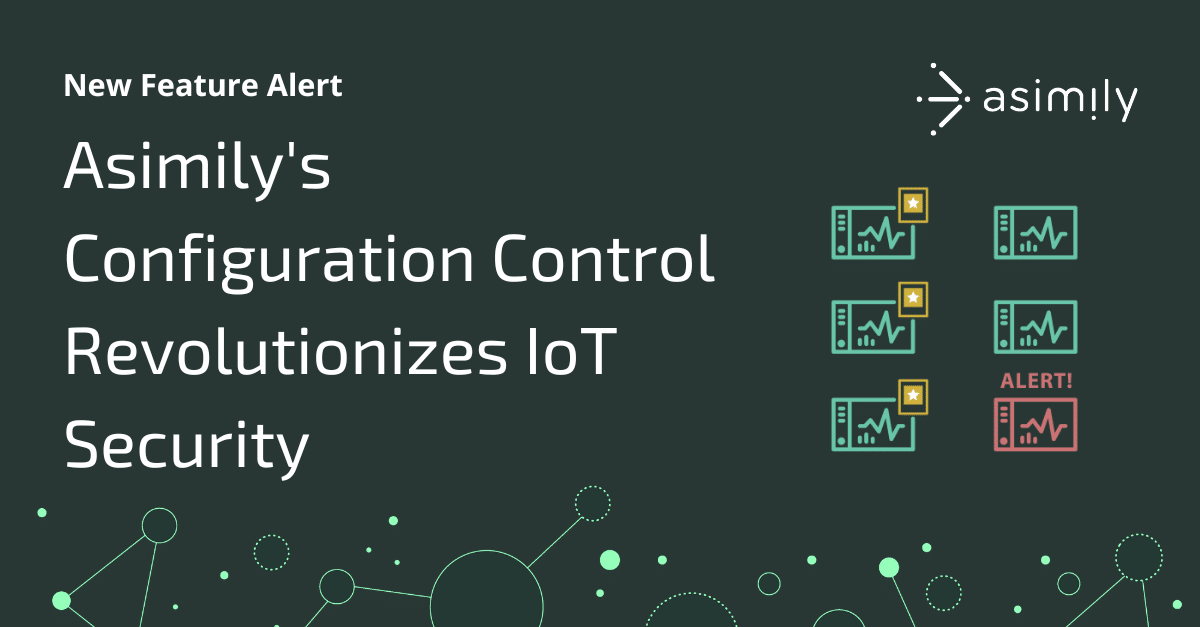The Drift Stops Here: Asimily’s Configuration Control Revolutionizes IoT Security

Say goodbye to the chaos of configuration drift. Asimily’s groundbreaking Configuration Control feature is here to revolutionize IoT, OT, and IoMT device security. This game-changing solution puts an end to the sneaky security vulnerabilities that creep in when devices are updated, tweaked, or repaired.
Taming the Wild West of Device Configurations
In the ever-changing landscape of connected devices, configuration drift is the silent killer of security. Whether it’s manufacturers making remote updates, overzealous technicians opening ports, or undocumented repairs, these changes can turn a fortress into a house of cards.
Your Digital Time Machine
Asimily’s Configuration Control acts like a digital time machine, preserving a snapshot of your devices’ known good states. When the inevitable drift occurs, you’ll have the power to:
- Instantly identify unauthorized changes
- Quickly revert to secure configurations
- Effortlessly maintain a robust security posture
- Reclaim Control of Your Connected Ecosystem
Configuration drift can leave you vulnerable. With Asimily’s Configuration Control, you’re always one step ahead of potential threats – enabling you to take the reins and ensure your IoT, OT, and IoMT devices remain secure, no matter what changes come their way.
Schedule a Demo of Configuration Control Today
How Asimily Configuration Control Fights Drift
Asimily recognizes the challenges inherent in fighting configuration drift. Quickly resolving drift in devices can secure critical information and ensure that the enterprise remains protected against possible attacks. That’s why we launched the new Asimily Configuration Control module.
This module, part of the Asimily platform, is designed to combat configuration drift in connected devices. The new module stores a snapshot of each device on your network, ensuring that users retain information about the known good state for each device. The information stored covers complete details about the device, including ports, services, external IP, topology, and more. Storing this information ensures that you have the most complete known good state snapshot to revert any changes. Further, the information lives in a system, not in a person’s head, enabling better change management.
Take Device Snapshots Based on Defined Policies
Snapshots can always be taken manually, one at a time, or more likely as a bulk action. Asimily Configuration Control also empowers security teams to take snapshots based on defined policies too. You may want to take a snapshot when a device’s risk score is at acceptable levels, such as when its exploit likelihood and impact are at acceptable medium or low levels. That way, if the risk score suddenly increases, you could see what may have changed.
Remove the Guesswork from Device Audits
The Asimily Configuration Control module also empowers you to set alerts to determine which changes should trigger alerts. That way you can see exactly when and how a configuration changed within change logs.
Reduce Alert Fatigue
Configuration control regularly checks configurations vs. the snapshot – to see if any changes happened. A logical thought for any security veteran is that this could result in a flurry of notifications, however, by classifying configurations into categories that can be set to high, medium, or low (or none) to suppress alerts. So if external IP addresses should never change, but device parameters change regularly – that can be used to trigger alerts.
Easily Restore a Device to a Known Good State
Asimily Configuration Control also empowers you with historical configuration data. You’re able to go back in time to view the recorded changes from any past date. This allows for easy comparison with a Known Good State or a past configuration for any reason.
Why You Need to Take Control of Configuration Drift
Connected devices are incredibly difficult to keep properly configured compared to standard information technology like workstations and servers. Every time someone accesses a system, whether remotely or locally, an accidental change can occur.
This is not always malicious access either. Software, people, and manufacturers all legitimately access connected equipment for various purposes. Health technology management (HTM) teams access MRIs during maintenance and might accidentally change a setting. Network technicians may need to send data from an IoT device and open up a port that wasn’t previously open. Resets to restore function often have the side effect of reversing security updates that keep devices safer.
These changes are often undocumented and potentially damaging. The lack of documentation means that security teams struggle to bring the devices back to their known good state.
The consequences of unmitigated configuration drift range from “a little extra work” to a “massive work-stopping issue”. No matter which level it is, configuration drift affects your organization in some capacity. The difference in impact, however, is how proactive you are in addressing the issue.
In a best-case scenario, configuration drift creates minor nuisances and operational headaches such as lost productivity, rework, difficult audits, and downtime of non-essential services.
The worst-case consequences of configuration drift include:
- Security vulnerabilities that lead to attacks and breaches – A misconfiguration can open up connected devices to attacks and data exfiltration from opportunistic attackers. Conversely, configuration control can help ransomware recovery by enabling you to easily revert to the known good state – saving you time when it matters most.
- Compliance violations that trigger fines and reputational damage – Misconfigurations can easily violate compliance regulations, especially if they make data more open to attack. These fines can be very expensive very quickly.
- Potential downtime of necessary equipment – Configuration drift may unintentionally break connections necessary for the system to function correctly. Reverting to a known good state is the only solution here to fix operational issues.
- Data loss from misconfigurations – Configuration drift could lead to unintentional data loss because of systems suddenly becoming inaccessible or data being deleted accidentally.
- Unpredictable and potentially anomalous device behavior – Any alterations to configuration could leave unapproved ports open to send data to legitimate users through anomalous connections. A technician can open a port to send data and then forget to close it again.
Configuration drift is one of those issues that can snowball quickly. Each resource that is misconfigured creates the risk of exposure to data loss, being used in an attack chain, or potentially even compliance violations. We’re proud to offer Asimily Configuration Control now to the market as a way to combat the challenges of drift in connected device configuration.
Contact us today to learn more about Asimily Configuration Control.
Secure Every IoT Device.
Automatically.
Cyber threats move fast — so should you. Asimily gives instant inventory and smart, prioritized risk mitigation insights for every IoT, OT, and IoMT device — so you can take action before threats strike.




